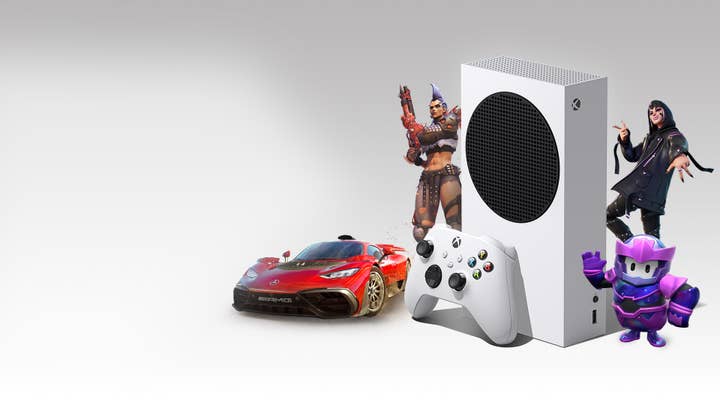Microsoft's hardware strategy looks more and more traditional | Opinion
Xbox Series X|S once presented a radically different vision; a console platform that would evolve and improve, ending the hardware generation cycle for good. What happened?
For all the interest piqued by the information accidentally revealed in Microsoft's FTC submissions this week, there's little in the way of surprising revelations in these documents.
In fact, if you'd been asked last week to predict Microsoft's hardware and software strategy over the coming years, pretty much the safest, most default answers would have lined up perfectly with the plans that emerge from the court filings.
We see, for example, an eight year life-cycle for the Xbox Series consoles with a fairly minor mid-cycle refresh due next year, and a pipeline for Bethesda's studios which has a handful of unknown titles but largely matches expectations in terms of sequels and remakes for the company's major franchises.
The only actual surprises, as such, are things that we knew about but thought the company had abandoned – such as its plans for a Game Pass console device in the $99 range (this was originally on the cards when Xbox Series X|S launched, but the idea was dropped, or at least pushed out into the long grass), or its ambition to buy Nintendo.
This latter is like some kind of memetic zombie that stalks the Xbox leadership from generation to generation. Perhaps Nintendo of America's headquarters being right next door to Microsoft's campus in Redmond makes this idea impossible to kill ("You know, I drove past the Nintendo building on the way in this morning, and I was thinking…"), but whatever the reason, the lunatic idea that the insanely cash-rich and successful Nintendo is a possible acquisition target for Microsoft – despite its shares still largely being owned by its founding family and current top executives – is one that is handed down from generation to generation of Xbox leadership. It's more nostalgic than surprising to see it crop up again in these emails.
If anything, the most striking thing about all of this information is precisely how normal it all is. The hardware and software strategy outlined for Xbox is normal almost to the point of being traditional – which is quite a departure from how the company was framing its console strategy a few years ago.
Coming off the back of the Xbox One's chilly commercial reception, it was pretty clear that Microsoft was at a crossroads regarding its game business, and questioning whether this was really a sector that fit with the company's overall strategy under Satya Nadella.
Xbox had just weathered a serious flop, and risked being seen as the last vestige of an ill-conceived consumer product strategy that included the likes of Zune and Windows Phone. Instead, the Xbox leadership managed to convince Microsoft's top executives to double down on their investment in gaming.
This was a feat of internal politicking that remains incredibly impressive, and undoubtedly saved the Xbox division – and it was accomplished, in part, by reimagining what the Xbox would actually be, positioning the actual Xbox console hardware as a relatively minor part of a wider platform strategy that would be broadly hardware-agnostic and instead centred around subscriptions and cloud services.
From the consumer standpoint, that had two material outcomes on the Xbox strategy. Firstly, there was Game Pass – a subscription service that would span Xbox and PC (and any other platform that would have it), leveraging the Xbox platform and ultimately the Azure cloud to put Microsoft on track to a dominant position in games as they shifted to an on-demand technology model and a bundled subscription business model.
Secondly, there was the promise that this was the last console generation – not because console hardware would cease to evolve, but because that evolution would become more rapid and regular, with the console being redefined not as a static set of hardware specifications but as a moving window over a range of hardware configurations which promised compatibility and a consistent (if not identical) experience up and down the range.
There would never be a generational leap again; consumers would upgrade to a better model that suited their budget and preferences in their own good time, confident that all their software and services would stay the same.

The physical embodiment of that promise, and still arguably the most interesting thing Microsoft has done in this generation, was the Xbox Series S – a console markedly less powerful than the leading-edge Series X or the PS5, but still sporting all the elements required to play current generation games at somewhat lower resolutions or framerates, and thus considered to be part of the same "platform" as its more powerful, expensive sibling.
This was all a radically different philosophy from what Sony was offering with the PS5 – a much more traditional console that was very clearly designed to exist for a generation before being superseded, just like the four PlayStation iterations before it, and whose core business model (most notably for Sony's high profile AAA first-party titles) was very much focused on selling games in the old-fashioned way, not on subscriptions or live services.
Whatever you thought of the future Microsoft was offering, it was a very different vision from Sony's – which meant that while the Series X and the PS5 were more or less on par in terms of hardware (at least close enough that it was obvious from the outset that third-party developers would going to treat them as identical from a performance target perspective), they offered a significant choice in terms of the market philosophy you were buying into.
To some extent, we've seen Sony being forced to move closer to Microsoft's vision – the company is clearly far less comfortable with game subscription models than its rival (perhaps recognising that an outright competition between such subscription services will simply be a financial game of chicken, inevitably won by the company with the deepest wallet), but it eventually grunted and rolled in that direction with the admittedly underwhelming PS Plus tiers.
The mid-cycle refresh for the Xbox we see planned in these documents is incredibly pedestrian
The movement is not all in one direction, though. If Sony has shifted to compete with Microsoft on subscriptions, then Microsoft has also quietly moved its console hardware strategy back towards something far more traditional, dropping all talk of the demise of console generations in the process.
I've speculated in the past that it was COVID that put paid to that vision – it was hard enough to keep existing hardware on the shelves during the pandemic, let alone trying to build out the Xbox line-up even further with devices at additional price and specification points. However, these emails make me wonder if Microsoft hadn't already walked back those ideas by the time the pandemic began to hammer supply chains, and had no real intention of resurrecting them when the world returned to normal.
The most basic element of that strategy in action would have been planning for a spec-bumped mid-cycle update to the Series X, which would start to give Microsoft the anticipated hardware edge over the generation-locked PlayStation 5. Freed from the confines of the generation refresh cycle, the Series X would have had at least one, possibly two or three updates (or successors) by the time Sony was ready to launch new hardware; the marketing copy welcoming PlayStation to finally catch up to the Series X.2 or X.3's existing performance almost writes itself.
Instead, the mid-cycle refresh for the Xbox we see planned in these documents is incredibly pedestrian. Even the arguably low-hanging fruit – updating the Series S to a somewhat higher spec at the same competitive price point, so as to start the process of migrating the Xbox installed base away from lower performing hardware – has been left firmly on the tree. Aside from some minor tweaks such as improved WiFi hardware and lower power consumption, the biggest change in the mid-cycle refresh seems to be removing the disc drive from the Series X (and making it round, I guess).
The same is true of Sony, it should be said; it seems clear that the PS5 revision we're likely to see in the relatively near future is a storage bump and a change to the form factor, also possibly involving the removal of the built-in disc drive (which I suspect will go down like a lead balloon with quite a significant chunk of their market, especially if the external drive peripheral which replaces it is in any way awkward or ugly).
This pushes Sony's mid-cycle refresh firmly into the camp of being a "PS5 Slim" rather than a "PS5 Pro," which is in line with Microsoft's strategy as well.
The PS4 Pro, in fact, seems more and more like an aberration – a product of a very specific moment in history when 4K televisions started proliferating at a rate that made a spec bumped console worthwhile – rather than a glimpse of the future. This is a shame, in some regards.
We're quite a few years from 2028 and who knows what technological advancements might force a rethink of this strategy
The recent performance patch to Jedi Survivor finally allows the game to hit a consistent 60FPS on the high-end consoles, but only by completely disabling ray-tracing (causing some horrible graphical issues in places), which is a reminder that the current consoles have a very promising technology feature (ray tracing) that comes at the cost of a huge performance downgrade, and could thus be ideal candidates for mid-cycle spec bumps if the platform holders were so inclined. They're not so inclined, though; these platforms look set to stay static, and the next performance improvement console owners will see is likely more than four years away.
While the opportunity for a spec bump is an intriguing path not taken, few developers will shed a tear for the PS5 Pro or Series X Pro that could have been – this would have been just one more platform to have to take into account for performance tuning and testing, and with the Series S already in the mix, the window for the specs a game is expected to support is already quite wide enough for most developers' tastes. Indeed, the notion of the Series S potentially still being on the market up until 2028 is going to provoke some loud sighs in those quarters.
The die isn't fully cast here, of course. We're quite a few years from 2028 and who knows what technological advancements might force a rethink of this strategy. But for now, it appears that both Sony and Microsoft have settled into a very traditional approach to hardware cycles and refreshes. For all the talk of this being the last generation of consoles, it would appear that the hardware generation model is set to remain a fixture of this market for quite a few more years.
Sign up for the GI Daily here to get the biggest news straight to your inbox









